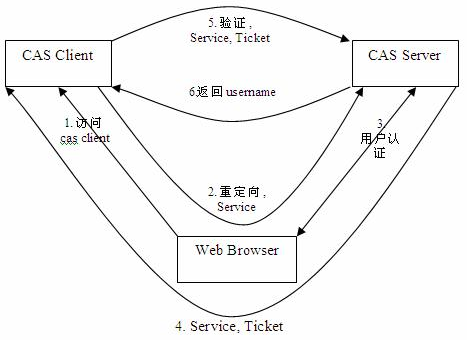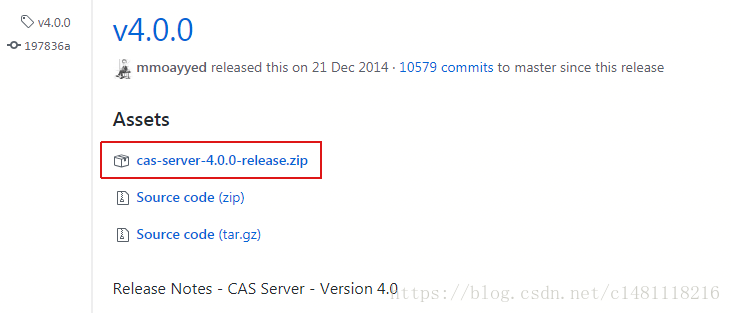一、什么是CAS
CAS 是 Yale 大学发起的一个开源项目,旨在为 Web 应用系统提供一种可靠的单点登录方法,CAS 在 2004 年 12 月正式成为 JA-SIG 的一个项目。CAS 具有以下特点:
【1】开源的企业级单点登录解决方案。
【2】CAS Server 为需要独立部署的 Web 应用。
【3】CAS Client 支持非常多的客户端(这里指单点登录系统中的各个 Web 应用),包括 Java, .Net, PHP, Perl, Apache, uPortal, Ruby 等。
从结构上看,CAS 包含两个部分: CAS Server 和 CAS Client。CAS Server 需要独立部署,主要负责对用户的认证工作;CAS Client 负责处理对客户端受保护资源的访问请求,需要登录时,重定向到 CAS Server。下图是 CAS 最基本的协议过程:

SSO单点登录访问流程主要有以下步骤:
1. 访问服务:SSO客户端发送请求访问应用系统提供的服务资源。
2. 定向认证:SSO客户端会重定向用户请求到SSO服务器。
3. 用户认证:用户身份认证。
4. 发放票据:SSO服务器会产生一个随机的Service Ticket。
5. 验证票据:SSO服务器验证票据Service Ticket的合法性,验证通过后,允许客户端访问服务。
6. 传输用户信息:SSO服务器验证票据通过后,传输用户认证结果信息给客户端。
二、CAS服务端部署
下载CAS4.0.0(选择4.0.0 的原因是:4.0.0以后打包比较麻烦,4.0.0版本内有打包好的war)。
下载地址为:

解压cas-server-4.0.0-release.zip,将cas-server-4.0.0-releasecas-server-4.0.0modules目录下的cas-server-webapp-4.0.0.war改名为cas.war,并放入tomcat目录下的webapps下。启动tomcat自动解压war包。浏览器输入http://localhost:8080/cas ,即可看到登录页面

这里有个固定的用户名和密码:casuser /Mellon
这个初始用户名和密码在caswebappscasWEB-INFdeployerConfigContext.xml中有配置

如果想新增一个用户,增加一个<entry>标签即可。
登录成功后会跳到登录成功的提示页面

三、CAS服务端配置
3.1 端口修改
如果我们不希望用8080端口访问CAS, 可以修改端口。
(1)修改TOMCAT的端口
打开tomcat 目录 confserver.xml 找到下面的配置

将端口8080,改为9100
(2)修改CAS配置文件
修改cas的WEB-INF/cas.properties
server.name=http://localhost:9100
3.2 去除https认证
CAS默认使用的是HTTPS协议,如果使用HTTPS协议需要SSL安全证书(需向特定的机构申请和购买)。如果对安全要求不高或是在开发测试阶段,可使用HTTP协议。我们这里讲解通过修改配置,让CAS使用HTTP协议。
(1)修改cas的WEB-INF/deployerConfigContext.xml
找到下面的配置

这里需要增加参数p:requireSecure="false",requireSecure属性意思为是否需要安全验证,即HTTPS,false为不采用。
(2)修改cas的/WEB-INF/spring-configuration/ticketGrantingTicketCookieGenerator.xml
找到下面配置

参数p:cookieSecure="true",同理为HTTPS验证相关,TRUE为采用HTTPS验证,FALSE为不采用https验证。
参数p:cookieMaxAge="-1",是COOKIE的最大生命周期,-1为无生命周期,即只在当前打开的窗口有效,关闭或重新打开其它窗口,仍会要求验证。可以根据需要修改为大于0的数字,比如3600等,意思是在3600秒内,打开任意窗口,都不需要验证。
我们这里将cookieSecure改为false , cookieMaxAge 改为3600
(3)修改cas的WEB-INF/spring-configuration/warnCookieGenerator.xml
找到下面配置

我们这里将cookieSecure改为false , cookieMaxAge 改为3600
四、CAS客户端入门案例
4.1 客户端工程1搭建
(1)创建Maven工程 (war)casclient_demo1 引入cas客户端依赖并制定tomcat运行端口为9001
<dependencies>
<!-- cas -->
<dependency>
<groupId>org.jasig.cas.client</groupId>
<artifactId>cas-client-core</artifactId>
<version>3.3.3</version>
</dependency>
<dependency>
<groupId>javax.servlet</groupId>
<artifactId>servlet-api</artifactId>
<version>2.5</version>
<scope>provided</scope>
</dependency>
</dependencies>
<build>
<plugins>
<plugin>
<groupId>org.apache.maven.plugins</groupId>
<artifactId>maven-compiler-plugin</artifactId>
<version>2.3.2</version>
<configuration>
<source>1.7</source>
<target>1.7</target>
</configuration>
</plugin>
<plugin>
<groupId>org.apache.tomcat.maven</groupId>
<artifactId>tomcat7-maven-plugin</artifactId>
<configuration>
<!-- 指定端口 -->
<port>9001</port>
<!-- 请求路径 -->
<path>/</path>
</configuration>
</plugin>
</plugins>
</build>
(2)添加web.xml
<?xml version="1.0" encoding="UTF-8"?>
<web-app xmlns:xsi="http://www.w3.org/2001/XMLSchema-instance"
xmlns="http://java.sun.com/xml/ns/javaee"
xsi:schemaLocation="http://java.sun.com/xml/ns/javaee http://java.sun.com/xml/ns/javaee/web-app_2_5.xsd"
version="2.5">
<!-- 用于单点退出,该过滤器用于实现单点登出功能,可选配置 -->
<listener>
<listener-class>org.jasig.cas.client.session.SingleSignOutHttpSessionListener</listener-class>
</listener>
<!-- 该过滤器用于实现单点登出功能,可选配置。 -->
<filter>
<filter-name>CAS Single Sign Out Filter</filter-name>
<filter-class>org.jasig.cas.client.session.SingleSignOutFilter</filter-class>
</filter>
<filter-mapping>
<filter-name>CAS Single Sign Out Filter</filter-name>
<url-pattern>/*</url-pattern>
</filter-mapping>
<!-- 该过滤器负责用户的认证工作,必须启用它 -->
<filter>
<filter-name>CASFilter</filter-name>
<filter-class>org.jasig.cas.client.authentication.AuthenticationFilter</filter-class>
<init-param>
<param-name>casServerLoginUrl</param-name>
<param-value>http://localhost:9100/cas/login</param-value>
<!--这里的server是服务端的IP -->
</init-param>
<init-param>
<param-name>serverName</param-name>
<param-value>http://localhost:9001</param-value>
</init-param>
</filter>
<filter-mapping>
<filter-name>CASFilter</filter-name>
<url-pattern>/*</url-pattern>
</filter-mapping>
<!-- 该过滤器负责对Ticket的校验工作,必须启用它 -->
<filter>
<filter-name>CAS Validation Filter</filter-name>
<filter-class>org.jasig.cas.client.validation.Cas20ProxyReceivingTicketValidationFilter</filter-class>
<init-param>
<param-name>casServerUrlPrefix</param-name>
<param-value>http://localhost:9100/cas</param-value>
</init-param>
<init-param>
<param-name>serverName</param-name>
<param-value>http://localhost:9001</param-value>
</init-param>
</filter>
<filter-mapping>
<filter-name>CAS Validation Filter</filter-name>
<url-pattern>/*</url-pattern>
</filter-mapping>
<!-- 该过滤器负责实现HttpServletRequest请求的包裹, 比如允许开发者通过HttpServletRequest的getRemoteUser()方法获得SSO登录用户的登录名,可选配置。 -->
<filter>
<filter-name>CAS HttpServletRequest Wrapper Filter</filter-name>
<filter-class>
org.jasig.cas.client.util.HttpServletRequestWrapperFilter
</filter-class>
</filter>
